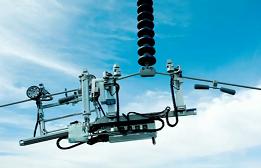
Canadian robots aren’t afraid of a little power. Hydro-Quebec’s Research Institution (IREQ) created an inspection and maintenance robot that can traverse overhead transmission lines even when they are buzzing at hundreds of thousands of volts. Called the LineScout, the IREQ robot is remotely controlled by workers on the ground, giving them an up close view of lines so they can detect damage, de-ice the conductor, and perform simple repairs. It has thermal-IR imaging so it can see ‘hotspots’ on the line and prevent the fraying and breaking of lines that leads to major blackouts and delays. In short, the robot has the potential to save Canada millions in lost energy and revenue as well as keeping human lives out of danger. No wonder it recently won the Edison Award from the Edison Electrical Institute. Check out the LineScout in action in the summary video below.
Robots seem destined to augment any job that humans find dangerous, dull, or difficult. Power line inspections seem to qualify under all three. The LineScout provides a distinct advantage over human workers inspecting the line by hand and if IREQ is able to commercialize the robot, we should expect it to see use in electric grids all over the world. In fact, similar bots in the research phase have already started to pop up. However, LineScout has been field tested dozens of times in British Columbia, in rough terrain, so it seems to have an edge. Eventually we’ll want these robots to be upgraded from remote controlled to semi or fully autonomous.
The aging North American electric grid is going to be a continued liability as power needs increase in the years ahead. The addition of a new generation of electric vehicles has the potential to really stress the system. In the near term we’ll need lots of inspections, lots of minor repairs, to avoid the catastrophic failures and region wide blackouts we’ve seen in the past. LineScout and other power transmission line robots of its kind will be essential.
But in the long term we’re going to need to upgrade the transmission system completely. Honestly this should have happened twenty years ago. Not only do we need more conductor, and newer lines, we also need an updated way to deal with routing power as demand fluctuates. In other words we need a smarter grid. To accomplish that we’re likely to start embedding millions of internet enabled sensors throughout power lines. These sensors will be able to relate much of the same information that LineScout can provide, only in real time. Such a smart electric grid is one of the potential (and very useful) applications of the Internet of Things.
Does that mean that LineScout is out of a job before it even gets deployed? Not at all. A sensor enabled smart grid is the future, but we’re still going to need inspection robots. Not just to verify sensor readings but to enact small repairs and perform maintenance. Robots like the LineScout are going to have a vital role in the smart energy ecosystem of the future, rest assured. I envision a time when the maintenance of the grid is almost entirely automated. Sensors locate potential dangers and then alert robots which come to take a closer look and automatically correct for small damage. When larger problems occur, then you call in the humans. That’s a setup that is likely to be repeated not just for energy grids, but all sorts of valuable industrial machines and networks. Platforms like LineScout are a sign that our most complex and vital systems will use robotics to help move themselves into future.
[screen capture and video credit: On Demand Production Network]
[source: HydroQuebec Press Release]


